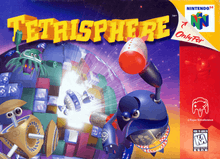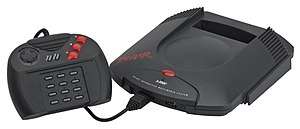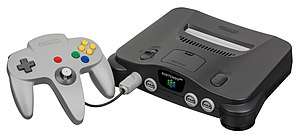Tetrisphere
Tetrisphere is a falling block puzzle video game for the Nintendo 64 (N64) console. Developed by Canadian company H2O Entertainment, a nearly complete version of the game was originally slated for release on the Atari Jaguar in early 1995. After Nintendo obtained its publishing rights, Tetrisphere was reworked for the N64 and released on the platform in North America on August 11, 1997, and the PAL regions in February 1998.
| Tetrisphere | |
|---|---|
 North American cover art | |
| Developer(s) | H2O Entertainment |
| Publisher(s) | Nintendo |
| Producer(s) | Michael Tam |
| Programmer(s) | Christopher Bailey |
| Artist(s) | Christopher Bretz Roland Longpre |
| Composer(s) | Neil Voss |
| Series | Tetris |
| Platform(s) | Nintendo 64 |
| Release | |
| Genre(s) | Puzzle |
| Mode(s) | Single-player, multiplayer (up to two players) |
Tetrisphere is a variant on Tetris in which various shapes are shifted across a wrapped three-dimensional grid resembling a sphere, and then destroyed. The objective of the game changes depending on the mode but generally consists of removing layers of shapes to reach the playing field's core. Despite very little domestic advertising, Tetrisphere enjoyed moderately good sales and a mostly favorable critical reception. Reviewers praised the game's originality and the musical score composed by Neil Voss.[3]
Gameplay
In most Tetris titles, a player's score is incremented as a result of completing "lines", where a row of brick pieces that is without gaps is removed from the 2D playing field. This both earns points and removes the completed row, making room for further pieces. However, in Tetrisphere, the goal is instead to remove bricks by forcing three of the same type of piece to touch as a result of a "drop". A drop is achieved when any brick falls, either as a direct result of the player releasing the currently held brick or when the brick which supports it from below is removed by any method. When three bricks of the same type touch, this triggers a "reaction". When a reaction occurs, the three bricks will glow brightly and implode, removing themselves from the field of play. Any other same-shaped blocks which are touching that reaction will also be removed in a chain reaction. For example, if a player has lines of nested "Z" pieces, and then drops another "Z" directly on top of one of the nested "Z"s, the one which was dropped will cause the piece below to implode, in turn causing all identical pieces touching that piece to explode, and so on. The only exception is that the pieces involved (including the original three) must abide by the rules which dictate which pieces are "touching". For example, any two matching pieces which are stacked must be exactly on top of each other, if they are both to be removed. Laterally, each piece obeys the rules specific to its shape. As an illustration of this point, "O" pieces (a 2x2 square, colored blue) and "I" pieces (a 3x1 or 1x3 rectangle, colored green or yellow) must have full contact on one side with one full side of another piece of the same shape, but all other pieces are considered "touching" if any part of them is in contact with another of the same shape.
There is a penalty incurred each time a player drops a brick without starting a reaction. The player may be penalized three times during a given play period, after which the round ends. While the player is scrutinizing the playfield, searching for likely reactions, a blue timer slowly counts down. When the timer reaches zero, a new yellow timer starts and the player begins to move towards the sphere at an increasingly fast pace (moving back to the default position for each piece dropped). That timer may also expire, causing a new and final red timer to begin, which moves the player towards the playfield even faster than the yellow timer. There is no penalty if the final timer reaches zero, but if the player gets too close to the playfield, the piece is dropped, causing a penalty if there is no reaction. The timer is slightly refilled for every piece removed and is reset to a full blue timer when a penalty is incurred. Removing 20 or more pieces will provide access to progressively more powerful assistive (or "magic") devices such as sticks of dynamite or rockets, that the player may employ at any time to remove large sections of the surface. Each type of explosive has its own pattern of removal, area of effect, and drawbacks. This also multiplies the player's score for each piece removed.
There are several modes of play available in Tetrisphere. The foremost single-player mode is "Rescue", which challenges the player to free a robot from the core of a sphere. As levels increase, the number of layers, size of the trapped robots, and types of pieces present increase. "Hide and Seek" has the same objective, and consists of a mix of different challenges, such as exposing a picture imprinted on the sphere's core. The "Puzzle" mode removes the drop timer, the combo weapons, and the infinite and random natures of the pieces supplied to the player. Instead, players must remove all blocks from the surface of the globe, given a finite number of sliding moves and drops of select pieces. The "Vs. CPU" and the two-player "Vs. Player" feature split-screen race to reveal a number of core squares. "Time-Trial" and "Practice" modes, as well as a training tutorial, are also available. Finally, a hidden "Lines" mode exists, where pieces cannot be dropped. Instead, blocks implode by themselves if three of the same type are lined up with each other.
Development
Tetrisphere was developed by H2O Entertainment, a game development company founded by Christopher Bailey, Michael Tam and Stephen Shatford, which was based in Calgary, Alberta, Canada.[4][5] The project originally started as an Atari Jaguar game entitled Phear and was on display for playing at Atari Corporation's booth during the Winter Consumer Electronics Show in 1995,[6][7][8] featuring gameplay similar to the "Tower" challenges found in the "Hide and Seek" mode of Tetrisphere, however, it involved the player in creating a hole of a specific size (3x2 for example) on the center of the sphere's core in order to progress into the next level.[6] Nintendo reportedly secured the rights to Phear after seeing the game showcased at Winter CES '95, and it was announced as a Nintendo 64 game at Nintendo Space World that same year.[9][10][11][12] H2O, which had completed a reverse takeover with Canadian Entech Resources Inc., began working exclusively for Nintendo during the game's development.
Around the time the company went public, Nintendo announced that Tetrisphere would be released in October 1996, boosting the company's stock. This didn't work for the partners in H20, though. "That was the first they had heard of the release date," the Canadian Business magazine said. The company strove to finish the game by October, but that wasn't found to be feasible. The delay significantly hurt H20's stock. "In terms of credibility and how investors perceived us, it really hurt us," partner Michaal Tam said. Once the planned release date had passed, Nintendo assigned six employees (approximately half a department) to the team.[13]
Nintendo also imposed strict conditions upon the developer. "We weren't able to disclose any information," H2O developer Michael Tam said.[13]
The game was developed on Silicon Graphics Indy, Indigo and O2 workstations. The music was composed in FastTracker 2 on a Pentium PC. The graphics were created with SoftImage running on Indigo and O2 workstations. The game was written in the C programming language and compiled to target 'Ultra64' development boxes for testing and bug tracking.
Senior developers improved the engine so that only part of the sphere is visible at any time, thus reducing the render load on the N64 hardware. The framerate was increased, allowing for a two-player mode not present in the first version.[12]
Stephen Shatford was the Sr. Game Designer and Tetris creator Alexey Pajitnov contributed to the game's design while working at Microsoft.[14] The North American release of Tetrisphere was ultimately delayed until August 1997, when it became the first puzzle game available on the Nintendo 64.[15]
The techno-style soundtrack for Tetrisphere was composed by Neil Voss. He began the project as a freelancer when it was on the Jaguar, then signed on as an audio director when it moved to the Nintendo 64.[16] Voss was the sole producer, composer, and sound engineer, but had help from in-house programmer David Pridie and staff from Silicon Graphics. Beginning with a cyberpunk style, the team transitioned to the techno genre due to the "uniqueness" of Tetrisphere as a puzzle game.[16] Voss explained that Tetrisphere features only stereophonic sound because "[...] for a game where the action is all around you, it could enhance gameplay and the immersive experience." Voss was also able to simulate surround sound.[17]
The composer frequently[16] used samples during production, specifically in the tracks "Extol", "Martist", and "Hallucid";[16] for instance, "Extol" uses a chorus of Balinese singers from a stock sample CD. The song titles were chosen as they would be if released on an album. Voss elaborated, "'Azule Lux' was supposed to be 'blue light' relating to one of the level backgrounds that impressed me visually. 'Snowy Mushrooms' is a drug reference and equally a reference to Nintendo's penchant for mushroom imagery. 'Phony' is because I felt that track was too close to Liam Howlett's (of the Prodigy) (me being phony). 'Extol' means to praise, which I felt was appropriate... Things like that."[16]
Reception
| Reception | ||||||||||||||||||||||||||||||||||||
|---|---|---|---|---|---|---|---|---|---|---|---|---|---|---|---|---|---|---|---|---|---|---|---|---|---|---|---|---|---|---|---|---|---|---|---|---|
| ||||||||||||||||||||||||||||||||||||
Tetrisphere received "favorable" reviews according to the review aggregation website GameRankings based on nine reviews.[18] Critics widely praised the innovative design,[24][29][33] numerous and engrossing modes of play,[21][24][26][29][33] and funky soundtrack with the ability for the player to select which track is played.[21][24][26][29] Jer Horwitz wrote in GameSpot that Tetrisphere "is precisely the sort of game that the Nintendo 64 really needs, offering revolutionary gameplay, impressive long-term value, and a set of visual effects that go above and beyond what Sony's PlayStation can handle."[24]
The graphics were also generally well-regarded.[21][24][26][33] Horwitz, who saw the game's demo as "Phear" at the Consumer Electronics Show, was particularly impressed with how much the graphics had been improved over the original Jaguar version, noting the smooth spheres and moving 3D backgrounds.[24] Next Generation dissented with the majority, stating that "Graphically, Tetrisphere doesn't live up to most other Nintendo 64 games - the most obvious flaw is an annoying pop-up as the player rotates the globe."[29]
Though they agreed that it is innovative, critics had varying experiences with the gameplay. Next Generation and GamePro both said the gameplay's complexity and unprecedented mechanics make it difficult to learn, but ultimately more rewarding.[29][33] GamePro said that "it actually requires a completely new mental discipline - which is just what the aging Tetris franchise needs."[33] GameSpot and Shawn Smith and Crispin Boyer of Electronic Gaming Monthly both contended that while mastery of the game is a challenge, Tetrisphere is enjoyable even without learning the nuances of its strategy.[21][24] Smith and Boyer's co-reviewer Dan Hsu instead said that mastering the game is impossible, since its 3D nature makes it impractical to get a full view of the field under the time constraints, and that tackling the puzzles blindly is boring.[21] IGN's Doug Perry simply commented that "Puzzler fanatics, however, may want to steer clear of this game for fear of permanent addiction."[26]
The game was distributed for sale among a network of 17,000 retailers in North America and Europe. Despite little advertising in the United States,[34] Tetrisphere managed to sell 335,000 copies in the region between its August release date and December 31, 1997. Out of 42 titles, Tetrisphere ranked at number 27 in terms of sales for Nintendo games in 1997.[35] H2O Entertainment announced that the game had sold 430,000 copies worldwide as of March 31, 1998.[36]
Nintendo Power ranked Tetrisphere at number 50 on its list of "100 Best Nintendo Games of All Time" in September 1997.[37] The magazine also gave it an award for "Best Soundtrack" for its annual awards for that year.[38] IGN considered the game's soundtrack to be the fourth best of any N64 game.[39]
References
- "Tetrisphere: It's Out Of This World". Redmond, WA: Nintendo of America. August 7, 1997. Archived from the original on 2012-11-13. Retrieved 2011-01-15.
- Bly, Steve (March 1998). "CVG Review - Nintendo 64 - Tetrisphere". Computer and Video Games. No. 196. Future Publishing. p. 64. Archived from the original on 2018-09-19. Retrieved 2018-09-18.
- "Tetrisphere Post-Mortem". Nintendo Power. Vol. 104. Nintendo of America. January 1998.
- Walters, Scott (January 31, 2017). "Phear Flyer (Front)". jagmod.com. Archived from the original on 2018-03-31. Retrieved 2018-09-19.
- Walters, Scott (January 31, 2017). "Phear Flyer (Back)". jagmod.com. Archived from the original on 2018-03-31. Retrieved 2018-09-19.
- National Videogame Museum (January 13, 2018). Atari Jaguar Phear Demo CES 1995. YouTube. Archived from the original on 2018-02-25. Retrieved 2018-09-19.
- "Dossier - Ils Arrivent Sur 64 Bits - 64 Bit Divers". CD Consoles (in French). No. 4. Pressimage. February 1995. p. 102. Archived from the original on 2018-09-19. Retrieved 2018-09-19.
- "WCES Special - Winter CES '95 - Atari". GameFan. Vol. 3 no. 3. DieHard Gamers Club. March 1995. p. 109.
- "Next Wave - N64 - Tetrisphere: The Jaguar's Loss Is The N64's Gain - Gamer's Edge: No Phear". Electronic Gaming Monthly. No. 98. Ziff Davis. September 1997. p. 102. Archived from the original on 2018-09-19. Retrieved 2018-09-19.
- Sheffield, Brandon (January 11, 2006). "Tetrisphere on the Jaguar!". GameSetWatch. UBM plc. Archived from the original on 2009-07-27. Retrieved March 24, 2010.
- "Featuring U64: Ultra 64 Games". Next Generation. No. 14. Imagine Media. February 1996. p. 65.
- IGN staff (March 10, 1997). "Tetrisphere Rears its Puzzled Head - H2O's almost Jaguar-bitten puzzle game, is new, improved and likely to arrive this summer". IGN. Ziff Davis. Archived from the original on 2018-09-18. Retrieved 2018-09-18.
- Charles Mandel (1997). "`Congratulations, Player No. 1...'". Canadian Business. Vol. 70 no. 13. Rogers Media. p. 114.
- Ali Almaci, Hasan (December 5, 2007). "Interview: Tetris - The Making of an Icon: Alexey Pajitnov & Henk Rogers Interviews (Page 3)". Kikizo. Superglobal Ltd. Archived from the original on 2011-07-28. Retrieved March 28, 2010.
- "Nintendo: Tetrisphere". Nintendo. Archived from the original on February 5, 1998. Retrieved March 25, 2010.
- IGN staff (June 15, 1998). "Composing Tetrisphere". IGN. Ziff Davis. Archived from the original on 2018-09-19. Retrieved September 18, 2018.
- IGN staff (June 16, 1998). "Interview With Neil Voss (Part II)". IGN. Ziff Davis. Archived from the original on 2018-09-19. Retrieved September 18, 2018.
- "Tetrisphere for Nintendo 64". GameRankings. CBS Interactive. Archived from the original on 2018-09-19. Retrieved September 18, 2018.
- McCall, Scott. "Tetrisphere - Review". AllGame. All Media Network. Archived from the original on November 14, 2014. Retrieved September 19, 2018.
- Edge staff (October 1997). "Tetrisphere". Edge. No. 50. Future plc.
- EGM staff (September 1997). "Tetrisphere". Electronic Gaming Monthly. No. 98. Ziff Davis. p. 50.
- McNamara, Andy; Andreson, Paul; Reiner, Andrew; Storm, Jon (September 1997). "Review – Tetrisphere". Game Informer. No. 40. FuncoLand. Archived from the original on September 9, 1999. Retrieved March 25, 2010.
- "Tetrisphere". GameFan. Vol. 5 no. 9. Metropolis Media. September 1996.
- Horwitz, Jer (August 19, 1997). "Tetrisphere Review". GameSpot. CBS Interactive. Archived from the original on June 23, 2006. Retrieved September 18, 2018.
- Cheung, Kevin (April 1998). "Tetrisphere". Hyper. No. 54. Next Media Pty Ltd. pp. 54–55. ISSN 1320-7458.
- Perry, Douglass C. (August 13, 1997). "Tetrisphere". IGN. Ziff Davis. Archived from the original on 2018-09-19. Retrieved September 18, 2018.
- Bickham, Jes (October 1997). "Tetrisphere (US)". N64 Magazine. No. 7. Future plc. pp. 60–61.
- Jarratt, Steve (March 1998). "Tetrisphere". N64 Magazine. No. 13. Future plc. pp. 40–41.
- "Tetrisphere". Next Generation. No. 35. Imagine Media. November 1997. p. 189. Archived from the original on May 8, 1999.
- "Tetrisphere". Nintendo Power. Vol. 100. Nintendo of America. September 1997. p. 106. Archived from the original on 2018-09-19. Retrieved September 18, 2018.
- "Tetrisphere". Nintendo Power. Vol. 99. Nintendo of America. August 1997. p. 96. Archived from the original on 2018-09-19. Retrieved September 18, 2018.
- Walk, Gary Eng (September 12, 1997). "Tetrisphere". Entertainment Weekly. No. 396. Time Inc. Archived from the original on 2018-09-19. Retrieved September 18, 2018.
- Dan Elektro (September 1997). "Tetrisphere". GamePro. No. 108. IDG Entertainment. p. 86. Retrieved September 18, 2018.
- IGN staff (August 29, 1997). "Tetrisphere Sales? They Ain't So Bad". IGN. Ziff Davis. Archived from the original on 2018-09-19. Retrieved September 18, 2018.
- IGN staff (February 2, 1998). "The Most Popular Games of '97". IGN. Ziff Davis. Archived from the original on 2018-09-19. Retrieved September 18, 2018.
- Staff (May 14, 1998). "H20 Announces Tetrisphere Sales". GameSpot. Archived from the original on March 4, 2000.
- "100 Best Nintendo Games of All Time". Nintendo Power. Vol. 100. Nintendo of America. September 1997. p. 95.
- "1997 Nintendo Power Awards". Nintendo Power. Vol. 104. Nintendo of America. January 1998.
- IGN Staff (June 14, 2000). "The Top 25 N64 Games of All Time: #11-15". IGN. Ziff Davis. Archived from the original on 2013-06-24. Retrieved September 18, 2018.

